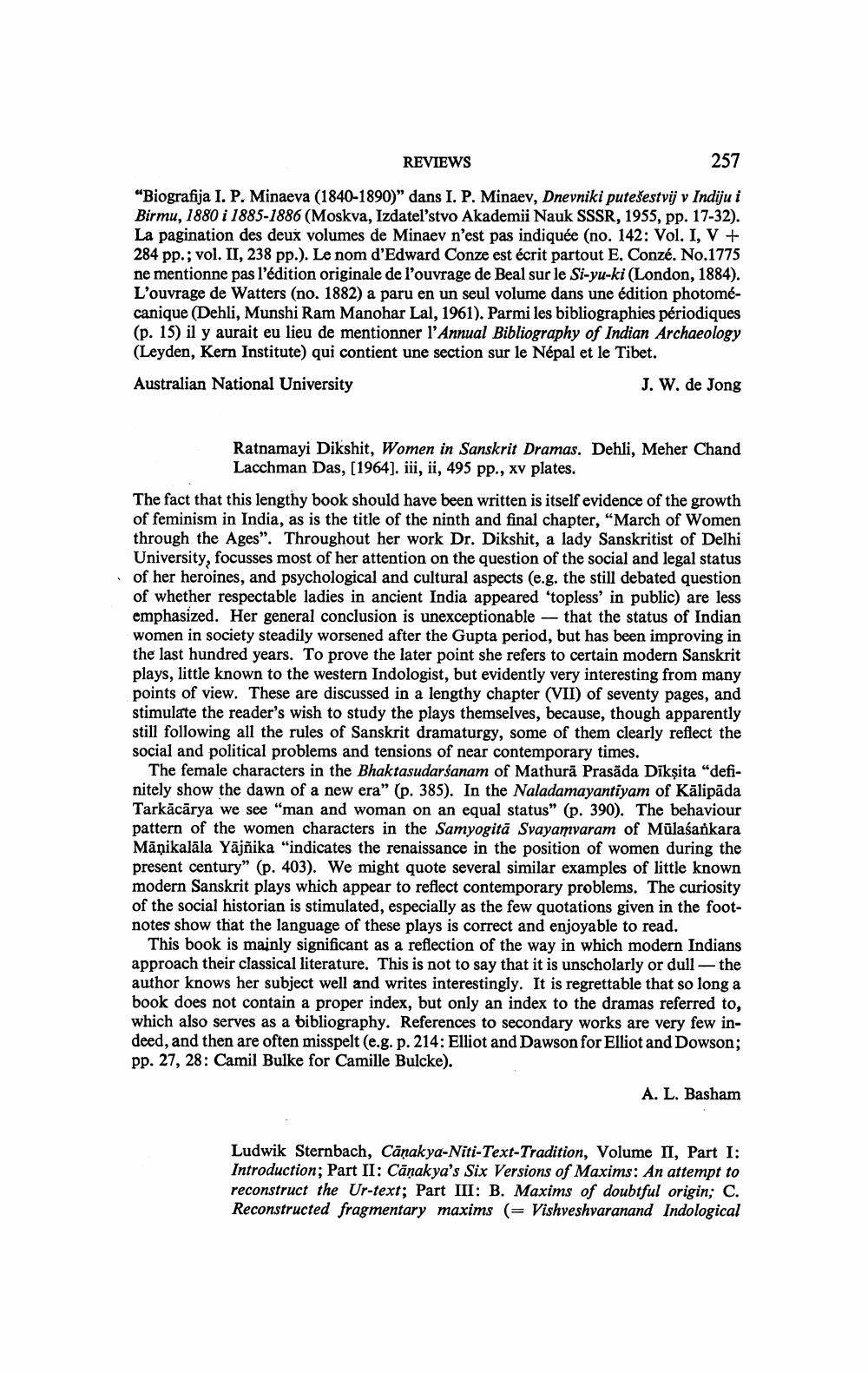________________ REVIEWS 257 "Biografija I. P. Minaeva (1840-1890)" dans I. P. Minaev, Dnevniki putesestvij v Indiju i Birmu, 1880 i 1885-1886 (Moskva, Izdatel'stvo Akademii Nauk SSSR, 1955, pp. 17-32). La pagination des deux volumes de Minaev n'est pas indiquee (no. 142: Vol. I, V + 284 pp.; vol. II, 238 pp.). Le nom d'Edward Conze est ecrit partout E. Conze. No.1775 ne mentionne pas l'edition originale de l'ouvrage de Beal sur le Si-yu-ki (London, 1884). L'ouvrage de Watters (no. 1882) a paru en un seul volume dans une edition photomecanique (Dehli, Munshi Ram Manohar Lal, 1961). Parmi les bibliographies periodiques (p. 15) il y aurait eu lieu de mentionner l'Annual Bibliography of Indian Archaeology (Leyden, Kern Institute) qui contient une section sur le Nepal et le Tibet. Australian National University J. W. de Jong Ratnamayi Dikshit, Women in Sanskrit Dramas. Dehli, Meher Chand Lacchman Das, [1964]. iii, ii, 495 pp., xv plates. The fact that this lengthy book should have been written is itself evidence of the growth of feminism in India, as is the title of the ninth and final chapter, "March of Women through the Ages". Throughout her work Dr. Dikshit, a lady Sanskritist of Delhi University, focusses most of her attention on the question of the social and legal status of her heroines, and psychological and cultural aspects (e.g. the still debated question of whether respectable ladies in ancient India appeared 'topless' in public) are less emphasized. Her general conclusion is unexceptionable -- that the status of Indian women in society steadily worsened after the Gupta period, but has been improving in the last hundred years. To prove the later point she refers to certain modern Sanskrit plays, little known to the western Indologist, but evidently very interesting from many points of view. These are discussed in a lengthy chapter (VII) of seventy pages, and stimulate the reader's wish to study the plays themselves, because, though apparently still following all the rules of Sanskrit dramaturgy, some of them clearly reflect the social and political problems and tensions of near contemporary times. The female characters in the Bhaktasudarsanam of Mathura Prasada Diksita "definitely show the dawn of a new era" (p. 385). In the Naladamayantiyam of Kalipada Tarkacarya we see "man and woman on an equal status" (p. 390). The behaviour pattern of the women characters in the Samyogita Svayamvaram of Mulasankara Manikalala Yajnika "indicates the renaissance in the position of women during the present century" (p. 403). We might quote several similar examples of little known modern Sanskrit plays which appear to reflect contemporary problems. The curiosity of the social historian is stimulated, especially as the few quotations given in the footnotes show that the language of these plays is correct and enjoyable to read. This book is mainly significant as a reflection of the way in which modern Indians approach their classical literature. This is not to say that it is unscholarly or dull -- the author knows her subject well and writes interestingly. It is regrettable that so long a book does not contain a proper index, but only an index to the dramas referred to, which also serves as a bibliography. References to secondary works are very few indeed, and then are often misspelt (e.g. p. 214: Elliot and Dawson for Elliot and Dowson; pp. 27, 28: Camil Bulke for Camille Bulcke). A. L. Basham Ludwik Sternbach, Canakya-Niti-Text-Tradition, Volume II, Part I: Introduction; Part II: Canakya's Six Versions of Maxims: An attempt to reconstruct the Ur-text; Part III: B. Maxims of doubtful origin; C. Reconstructed fragmentary maxims (= Vishveshvaranand Indological




